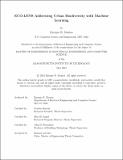| dc.description.abstract | The link between global climate change and biodiversity is well recognized. Humandriven destruction and degradation of ecosystems amplify the negative and complex impacts of climate change, increasing the strain on remaining ecosystems and wildlife. Therefore, it is essential for climate change mitigation efforts to include strategies that protect and conserve biodiversity, enhancing ecosystem productivity, resilience, adaptability, and sustainability. Identifying and prioritizing ecosystem functions that support key ecosystem services is crucial for targeted conservation actions, particularly in urban areas. Urban regions have doubled in size since 1992, and compared to 2020, they are expected to expand by 30% to 180% by 2100. Most of this growth will occur in the global south, in regions rich in biodiversity, and will impact global ecosystems through resource demands, pollution, and climate effects. Urban biodiversity management is an emerging discipline, with significant gaps in our understanding that are vital for improving biodiversity conservation policies and management in urban areas to support global biodiversity goals. As research on ecosystem services progresses, the importance of urban vegetation in promoting the sustainability of urban ecosystems and environments is increasingly recognized. Recently, remote sensing technology has become a valuable tool for obtaining detailed information and mapping urban vegetation, offering numerous benefits. Leveraging remote sensing tools in the form of satellite imagery and LiDAR enables extensive coverage of urban areas, providing an opportunity to evaluate biodiversity patterns across entire regions without causing disturbance to ecosystems. While remote sensing has significantly improved our capacity to monitor landscape-level biodiversity losses, its application for assessing urban biodiversity has been limited. This research paper offers several ways of leveraging remote sensing and machine learning techniques to close the existing data gap. Through this paper, we showcase the potential use of Normalized Difference Vegetation Index (NDVI), satellite imagery, and LiDAR point clouds to provide data for urban biodiversity assessment, management, and conservation. By leveraging technologies and the data they provide, urban planners, policymakers, and conservation practitioners can make more informed decisions to protect and enhance urban biodiversity systematically. | |
